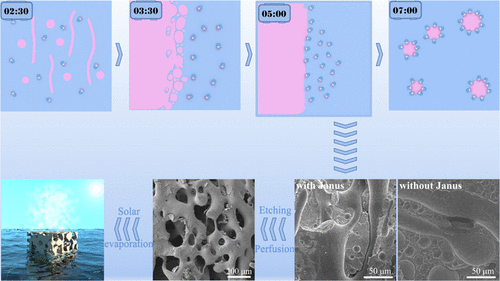当前位置:
X-MOL 学术
›
Ind. Eng. Chem. Res.
›
论文详情
Our official English website, www.x-mol.net, welcomes your feedback! (Note: you will need to create a separate account there.)
Increased Continuity of the PA6 Phase from the PS Matrix Induced by Migrating Janus Particles and Its Application in Thermal Conductivity
Industrial & Engineering Chemistry Research ( IF 4.2 ) Pub Date : 2021-09-21 , DOI: 10.1021/acs.iecr.1c03202 Jiahe Lin 1 , Chongyi Chi 1 , Yuxia Zhang 1 , Jianrong Lin 1 , Qinhui Chen 1, 2
Industrial & Engineering Chemistry Research ( IF 4.2 ) Pub Date : 2021-09-21 , DOI: 10.1021/acs.iecr.1c03202 Jiahe Lin 1 , Chongyi Chi 1 , Yuxia Zhang 1 , Jianrong Lin 1 , Qinhui Chen 1, 2
Affiliation

|
The interfacial interaction determines the morphology of polymer blends and affects their properties. Herein, snowman-like SiO2@polystyrene (PS) Janus particles (JPs) were synthesized by the phase separation method, and the JPs modified by epoxysilane (EJPs) were used as compatibilizers on PS/PA6 blends. The morphology transformation of PS/PA6 blends and the migration process of EJPs in blends with different processing times were studied. With prolonged processing time, EJPs migrate to the phase interface gradually. PS/PA6 blends with EJPs undergo a similar morphology transformation of sea island, cocontinuous, and sea island to that without EJPs. However, EJPs play refining and fibrotic roles on the dispersed phase, which increases the continuity of PA6. As a result, a continuous PA6 skeleton can be obtained by etching the PS phase from PS/PA6 blends (60/40/1.0) mixed for 5 min. The PA6 skeleton perfused with reduced graphene oxide (rGO) shows electrical conductivity. Moreover, PA6/rGO composites show perfect solar vapor generation properties due to the capillary action of microchannels and the photothermal conversion property of rGO. The water evaporation rate reaches 1.84 kg/m2 h under 1 sun irradiation in the presence of PA6/rGO9 composites, which is 4.7 times more than pure water. The phase separation method is one of the promising industrialization methods for Janus preparation, and PA6/rGO9 composites are expected to be used for solar water evaporators.
中文翻译:

由迁移 Janus 粒子引起的 PS 基质中 PA6 相的连续性增加及其在热导率中的应用
界面相互作用决定了聚合物共混物的形态并影响它们的性能。在此,雪人状 SiO 2@聚苯乙烯 (PS) Janus 粒子 (JPs) 通过相分离法合成,经环氧硅烷 (EJPs) 改性的 JPs 用作 PS/PA6 共混物的增容剂。研究了 PS/PA6 共混物的形态转变和 EJPs 在不同处理时间的共混物中的迁移过程。随着处理时间的延长,EJPs 逐渐迁移到相界面。PS/PA6 与 EJPs 的混合物经历了与没有 EJPs 的类似的海岛、共连续和海岛形态转变。然而,EJPs 对分散相起到细化和纤维化作用,这增加了 PA6 的连续性。因此,通过蚀刻 PS/PA6 混合物 (60/40/1.0) 混合 5 分钟的 PS 相,可以获得连续的 PA6 骨架。灌注有还原氧化石墨烯 (rGO) 的 PA6 骨架显示出导电性。此外,由于微通道的毛细管作用和 rGO 的光热转换特性,PA6/rGO 复合材料显示出完美的太阳能蒸汽生成特性。水蒸发率达到1.84 kg/m在 PA6/rGO9 复合材料存在下,1 次阳光照射下2小时,是纯水的 4.7 倍。相分离法是Janus制备的有前景的工业化方法之一,PA6/rGO9复合材料有望用于太阳能水蒸发器。
更新日期:2021-09-29
中文翻译:

由迁移 Janus 粒子引起的 PS 基质中 PA6 相的连续性增加及其在热导率中的应用
界面相互作用决定了聚合物共混物的形态并影响它们的性能。在此,雪人状 SiO 2@聚苯乙烯 (PS) Janus 粒子 (JPs) 通过相分离法合成,经环氧硅烷 (EJPs) 改性的 JPs 用作 PS/PA6 共混物的增容剂。研究了 PS/PA6 共混物的形态转变和 EJPs 在不同处理时间的共混物中的迁移过程。随着处理时间的延长,EJPs 逐渐迁移到相界面。PS/PA6 与 EJPs 的混合物经历了与没有 EJPs 的类似的海岛、共连续和海岛形态转变。然而,EJPs 对分散相起到细化和纤维化作用,这增加了 PA6 的连续性。因此,通过蚀刻 PS/PA6 混合物 (60/40/1.0) 混合 5 分钟的 PS 相,可以获得连续的 PA6 骨架。灌注有还原氧化石墨烯 (rGO) 的 PA6 骨架显示出导电性。此外,由于微通道的毛细管作用和 rGO 的光热转换特性,PA6/rGO 复合材料显示出完美的太阳能蒸汽生成特性。水蒸发率达到1.84 kg/m在 PA6/rGO9 复合材料存在下,1 次阳光照射下2小时,是纯水的 4.7 倍。相分离法是Janus制备的有前景的工业化方法之一,PA6/rGO9复合材料有望用于太阳能水蒸发器。



























 京公网安备 11010802027423号
京公网安备 11010802027423号